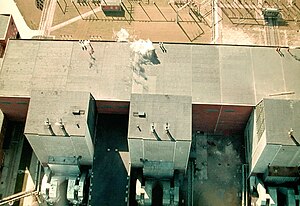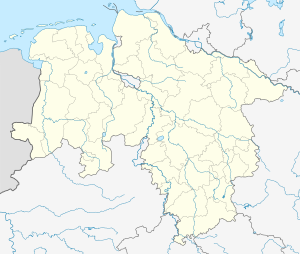Schilling power plant
| Schilling power plant | |||
|---|---|---|---|
| The three blocks seen from the chimney | |||
| location | |||
|
|
|||
| Coordinates | 53 ° 37 '1 " N , 9 ° 32' 2" E | ||
| country | Germany | ||
| Waters | Elbe | ||
| Data | |||
| Type | Thermal power plant | ||
| Primary energy | Fossil energy | ||
| fuel | Heavy fuel oil | ||
| power | 3 × 125 MW | ||
| owner | NWK Nordwestdeutsche Kraftwerke AG | ||
| operator | NWK | ||
| Project start | 1957 | ||
| Start of operations | 1962 | ||
| Shutdown | Late 1980s | ||
| boiler | 3 Benson boilers a 430 t / h live steam at 530 ° C and 186 bar | ||
| Chimney height | 220 m | ||
The Schilling power plant was a heavy oil- fired oil power plant with three blocks, each with an output of 125 MW, near the Stade KKS nuclear power plant .
Construction work began in 1957. The first unit went into operation in 1960. Unit 2 followed in August 1962 and Unit 3 in February 1964. The firing took place as front firing on 18 oil burners with a fuel throughput of 1,700 kg / h each. The power plant including the associated tank farm has now been shut down and dismantled. Since it was mainly used to supply Hamburg with electricity and fed its electricity into the Hamburg-Nord substation, the first overhead line crossing of the Elbe near Stade , Elbe crossing 1 , was built at that time.
It was taken out of service in the late 1980s. Blocks 1 to 3 were dismantled between 1993 and 1994, as was the tank farm (TLS). The chimney was then dismantled. On December 17, 2005, the last element of the machine house was blown up, since mid-2006 there have been no buildings in the power plant apart from the intake structure. The once characteristic, 220 m high chimney was possibly the highest in the world at the time of its construction. This should distribute the flue gas with its high proportion of sulfur dioxide evenly in the atmosphere. Desulphurization systems were only made mandatory in the 1980s.






